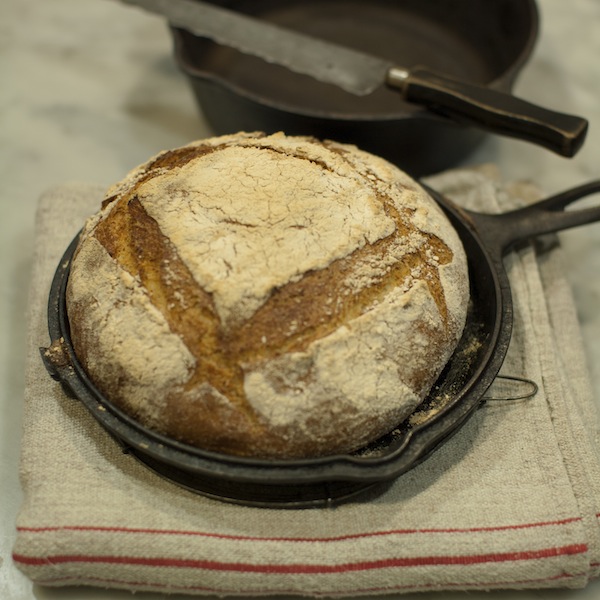If you’re a proper breadhead, you’ve probably taken a stab at Jim Lahey’s no-knead bread by now. It seems like every baker has their own rendition of this simple recipe, but ours stands out from the crowd with its extra dimension of flavor and texture from stone-ground flour. Agave nectar lends a subtle sweetness and rich color, making this loaf a beautiful addition to any meal. The best part of all? Time does most of the work for you. Start it in the morning and you’ll be wowing your dinner guests with freshly baked bread without breaking a sweat. It’s so good it happens to be Leslie’s favorite go-to bread recipe when she doesn’t have time to swing by the bakery. Now you have to try it!
The recipe below is meant to be baked in a standard dutch oven. Pick up our cookbook, More from Macrina, for modifications using a double dutch oven.
One-Day Artisan Whole Grain Loaf
Click here to print this recipe!
Ingredients
1 3/4 cups lukewarm filtered water (about 80°F)
2 tablespoons amber agave syrup
2 teaspoons active dry yeast
1 1/4 cups (5 1/2 ounces) unbleached all-purpose flour
1 cup (4 1/2 ounces) stone-ground whole wheat flour
1/2 cup (2 ounces) stone-ground rye flour
2 teaspoons kosher salt
Preparation
Makes One 9-Inch Round Loaf
1. Line a medium bowl with a clean cotton flour sack towel and sprinkle it heavily with flour. Set aside.
2. Combine the water and agave syrup in a large bowl. Sprinkle the yeast over the surface of the liquid and whisk gently until it has dissolved. Let the mixture sit for about 3 minutes to activate the yeast.
3. Add the flours and salt. Using a rubber spatula, mix the ingredients for 2 to 3 minutes by pulling the spatula through the dough and flipping it over to simulate a kneading motion. The dough will have no more flour pockets and will be quite wet. Cover the bowl with plastic wrap and let the dough rise for 2 hours at warm room temperature (75 to 80°F) or until the dough has doubled in size.
4. Lightly sprinkle the top of the dough with flour and do a baker’s turn. Cover the bowl with plastic wrap and let the dough rise again at room temperature for another 2 hours.
5. When the dough has risen, do a second baker’s turn. Again, cover the bowl with plastic wrap and let the dough rise at room temperature for another hour.
6. Transfer the dough onto a floured work surface and do a third baker’s turn – this time on your work surface rather than in the bowl. Invert the loaf so that it is seam side down, then cup your hands around the dough ball, resting the outer portion of your hands on the work surface. Move the ball in a circular motion to tighten it at the base. Invert the rounded loaf again and place it seam side up in the towel-lined bowl; lightly cover the top with the overhanging towel. Let it rise at room temperature until it is about 1 1/2 times its original size, about 1 hour. This dough should have a texture like Jell-O, slightly under-proofed. If it has risen too much at this stage, it will collapse when you place it in the dutch oven.
7. One hour before baking, preheat the oven to 450°F. Place the cast iron dutch oven and its lid inside to preheat. Flip the dough onto your floured work surface and slowly remove the cloth. With a sharp paring knife or razor blade, cut a 1/8-inch-deep, 4-inch square on the top of the dough. Using oven mitts, quickly retrieve the dutch oven and remove the lid. Gently drop the dough into the dutch oven, replace the lid and slide into the oven.
8. Bake for 30 minutes, then remove the lid. Continue baking until the loaf is deep brown and very crusty, about another 20 minutes.
9. Flip the loaf out onto a wire rack (the loaf should release easily from the pan) and let cool completely before cutting.

